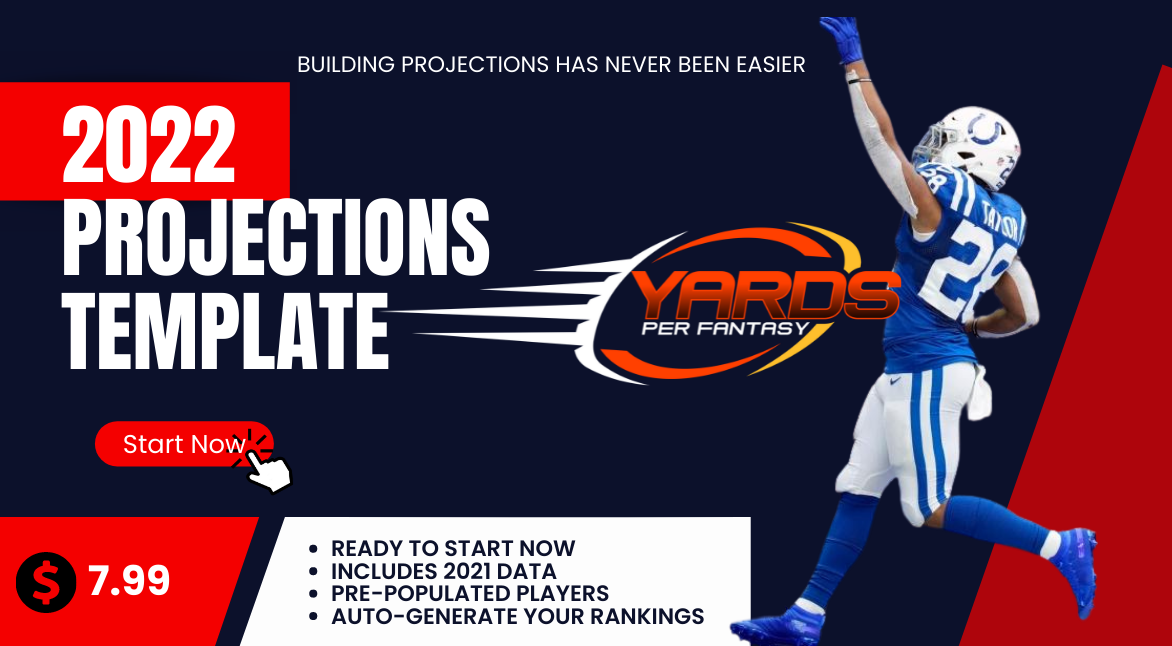 Draft With Us On Underdog! Use Promo-Code: YARDSPER for a 100% deposit match up to $100!
Draft With Us On Underdog! Use Promo-Code: YARDSPER for a 100% deposit match up to $100!
The concept of the ‘Running Back Deadzone’ is one that has become a well known and accepted principle over the past couple of seasons. I’m not totally sure where it originated from but I first heard Ben Gretch (@yardspergretch) lay it out and JJ Zachariason (@lateroundqb) produces great content on the subject every season.
What is the deadzone?
For anyone new to the idea, the Running Back Deadzone is the concept that Running Backs drafted in certain rounds of fantasy football drafts are unlikely to return value. They’re a reach (often fuelled by the panic of the position drying up) and the alternative players around them are a better bet to return value. There’s a bit of conjecture as to which rounds are the deadzone but it generally starts in round four.
I’ve been thinking a bit about this deadzone recently, what it means, and whether the landscape is shifting. The aforementioned JJ made his name on a late round quarterback strategy that has somewhat changed in recent years due to shifts in the market, I wondered if the same was going to happen with this deadzone.
Where is the deadzone really?
First thing I wanted to approach was the arbitrary idea that the deadzone is based on draft rounds. My theory: it’s not the round they’re drafted but how they rank amongst running backs that we should be interested in. That way, if the landscape shifts and running backs move down draft boards (or up for that matter), the deadzone will also shift.
On average, the deadzone kicks in around RB20. Proof of concept: the average RB20 finish is equivalent to around WR30 and you can draft the WR30 in round seven instead of early round four.
what do we need from running backs in this range?
Digging the numbers a bit further, there’s a noticeable drop off in total points after around RB10. Wherever you draft a player, you need them to return value and if you’re in these middle rounds of the draft you need that player to have upside potential. Put this together, if you’re drafting a running back in this deadzone, a top 10 finish needs to be in the likely range of outcomes.
Ok, so what does a running back need to do to be a top 10 back. Well, based on recent history they need something like 220+ carries, be a significant part of the passing game, or get an exorbitant amount of touchdowns. Touchdowns are fluky and unpredictable so trying to bank on these is dangerous. That means we need to be looking at the carries and the passing game work.
Based on this volume, that means we need a clear lead running back, not someone in a committee.
PROJECTIONS TEMPLATE – GET NOW!
What do deadzone running backs have in common?
The other thing I did was look at the running backs in the past few years who have been drafted in the deadzone to see if there are common characteristics. Here’s the categories that most of the running backs in this zone fall into:
- Poor pedigree but pushed up by potential workload (e.g. Mike Davis at Atlanta last season; Myles Gaskin at Miami)
- Rookies (not including those with obvious workhorse situations like Najee Harris)
- Committee backs
This reinforces the previous point, if we’re going to draft a running back in the first portion of the draft they need to be the clear lead back or a big part of passing game.
Who does that give us for 2022?
Looking through the teams who clearly have someone in this situation, we have (these are in team order – don’t yell at me for having Taylor half way down!):
- James Conner
- Christian McCaffrey
- David Montgomery
- Joe Mixon
- D’Andre Swift
- Aaron Jones (passing game work)
- Jonathan Taylor
- Josh Jacobs
- Austin Ekeler
- Dalvin Cook
- Alvin Kamara
- Najee Harris
- Leonard Fournette
- Derek Henry
That’s 13 running backs.
Now the next tier of players who have shown to be in this category but we have a few concerns over age, injury, etc
- Ezekiel Elliott
- Cam Akers
- Saquon Barkley
That takes us to 16 running backs.
And finally, the next tier down which is young running backs who are no longer rookies and have the pedigree to take a lead role:
- Javonte Williams
- JK Dobbins
- Antonio Gibson
These three have some alarm bells for me. Yes they have the pedigree and the potential but right now they’re stuck in a committee – that’s running back deadzone stuff. We’re going to convince ourselves to ignore the deadzone issues on Javonte and JK at least because of the potential but I’m nervous.
There’s one more player who absolutely belongs in the top 20 but I just can’t figure out where to put him. He’s sort of a clear lead back but the committee element is enough that, without more work in the passing game (which he doesn’t get), he never quite gets in to that top tier. That’s Nick Chubb.
That gives us 20 running backs, would you look at that. Remember I said the deadzone starts around RB20?
Who does that leave in the deadzone?
Right now, there’s a few running backs who are actually higher up this list that are pushing some of these guys down in to the deadzone. So technically players like Elijah Mitchell, Clyde Edwards-Helaire and Damien Harris are top 20. They are falling late round three, early round four though (according to fantasy football calculator ADP at the time of writing) and these are classic deadzone candidates in my mind:
- Elijah Mitchell
- Clyde Edwards-Helaire
- Damien Harris
- AJ Dillon
- Rashaad Penny
- Michael Carter
- Miles Sanders
- James Robinson
- Melvin Gordon
These are all classic committee backs.
Right now, according to the same ADP I reference above, there are players going in the deadzone who I noted as having the right situation. I suspect they’ll get pushed up out of the zone by full on redraft season but for now James Conner, Leonard Fournette, Josh Jacobs and Saquon Barkley all find themselves in this area. They are values I’d be looking to exploit if they stay there, those are players that I don’t believe should be in this deadzone.
The other player in there that’s a wildcard right now is Travis Etienne. He has the pedigree and talent but we haven’t seen it in the NFL yet and he’s coming off a serious injury. Perhaps the deadzone is the right spot for someone who is technically a rookie in all but name.
Lets wrap this up
The running back deadzone is a thing but be careful about pinning it to rounds of the draft, pin it to the running back rankings and the players that fall in certain categories instead.
- There’s 13 running backs with a solid situation that gives them the top 10 potential
- There’s another three that can get there too if you believe
- There’s three more that have the upside that could be worth the risk in the deadzone (maybe)
- And there’s Nick Chubb
Outside of that, stay clear of running backs in the middle rounds of your draft, come back to the backups with upside later on. If you missed on running back in the first few rounds and these players are all gone, that’s how Zero RB happens and you should embrace it at this point.








